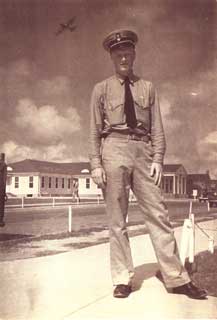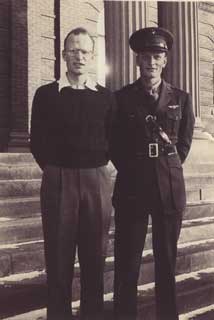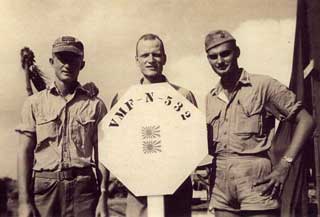Edward Sovik: Crash Landing On Saipan
Edward Sovik flew an F4U Corsair with a night fighter squadron in the South Pacific during World War II. In a 2003 oral history, he told of a very close call during a mission over Pagan, a small island near Saipan.
Audio
Transcript
TS: Saipan was the last of the four stops you made?
ES: Yes.
TS: That was secured, I think, in the summer of 1944.
ES: Right. July. We had been at Saipan flying off a Japanese field. They had a blacktop Japanese field at the south end of the island and we were flying off. It had been patched up well enough so it was a good field. We had been there a few days when the skipper got instructions saying that there's a little island called Pagan about two or three hundred miles north of Saipan. There was a little airport there and a seaplane base. Admiral King and Admiral Nimitz [U.S. naval commanders, Pacific area] were scheduled to arrive on Saipan the next day, and some Navy reconnaissance plane had flown by that island and had reported that they had seen some airplanes there for the first time.
TS: Japanese airplanes?
ES: Japanese airplanes there for the first time. And somebody got the notion that the Japanese were aware that King and Nimitz were going to be in Saipan. They were getting ready to make some trouble for them. So we got this assignment to go up and attack. If there was anything there, attack it and destroy it.
TS: This would be at night or during the day?
ES: This is night. So we loaded up four airplanes, and I was flying on major's wing, and Nate Pudell and Bowman, two other fellows, were flying the other section.
TS: So you took off.
ES: We took off and there was a weather front, so we had to climb above it and that meant going up to sixteen, eighteen thousand feet, I suppose. But we got across it and started down and our plan was to attack from the west. Our plan was to go in and attack starting at that seaplane base and strafe and destroy their other field if we could or do whatever damage we could. We thought that we might surprise them. And I guess we did. But the major went down with me on his wing. And as we were approaching the island, his plane, which was simply a black shadow, and the island was a black shadow, and they merged and I couldn’t see his plane. So I said, "I'm not going to follow this in and maybe shoot down our own airplane." So I pulled out and I went across at a higher level. The major and the other two planes went on through and did their damage, whatever it was.
TS: They were carrying bombs under the planes?
ES: Yes. Under the plane. Apparently we did surprise them, because they reported that they had not gotten much fire. But I went across the island then and decided that I would go back and go in from the east to the west. By the time I got there the Japanese were very alert and they had all kinds of fire. Incendiaries coming up from both sides as I flew down this runway. I was going very fast and firing and trying to see what was going down there too. There weren't any airplanes there. I could see that much. But I did get hit on both wings and my cabin and several other places. The wingtips of the F4U for maybe five feet were fabric.
The fabric was burning on both sides, both side of me. I thought - I thought, "Should I turn over and jump out and land in the ocean, parachute? Should I try to make a landing, a water landing, in the dark?" And I had my hand on the handle for the greenhouse [glass cockpit] to open that up, but I was going fast and I didn’t want to jump out while I was going fast and I was pulling up. But meanwhile the control of the airplane was going off kilter, and I found that to keep going where I intended to go I had to use cross-controls. Full left rudder and full right stick and full power. And I got from being right down on the ground to—I got up to fifteen hundred feet and the speed had blown the fire out.
So I discovered to my joy [chuckles] I was still alive, still functioning, the plane's engine was running fine. I was at full power and controlling it, and I was flying at a hundred and sixty-five miles and I experimented a little bit. I couldn't slow down. I thought, "How am I - do I have gas enough to get home? Have they shot the gas tanks?" By that time there was a glimmer of light and I could look out and see the wings were pretty bad. Some damage. There was a door over an ammunition case that was open and some of the bands of ammunition were coming out of it, so something had hit that. And I tried then to radio to see if I could get in touch with my friends, but I couldn't. I couldn't reach Saipan, but I should have been able to reach the planes.
TS: So you flew back all by yourself.
Yes. And halfway back, I was getting really confident, though a little awkward. I was fussing with the radios and on one of the frequencies on VHF I heard some English being spoken. So I looked around and there in front of me I saw an American destroyer. I was about fifteen hundred feet and I couldn't fly, I couldn't climb, because I lost speed and therefore control. I didn't want to drop lower than that, so I was holding my own at fifteen hundred feet.
So I flew over that destroyer, and on this frequency where I had heard this talking, I called and I said, "If you hear me, get in touch with Saipan and tell them to be ready for a crash landing." And I got no response, so I didn't know if they had heard me or hadn't heard me. But when I got to Saipan it became very quickly clear. I didn't want to jump. I could have made a parachute jump into the bay. But doing it at the speed I was going and that high tail on the F4U, you jump out of the airplane and you can be cut in half with that tail. So I didn't want to do that. I didn’t want to, but there was the field, and I thought, "I can make a crash landing even at high speed." I tried the wheels and they just wouldn't work.
So I decided that I would fly it in, and I did. And I flew it into a grass verge. Saipan is partly coral, and under the grass on the side of the runway—I didn't know this, but under the grass is this knobby, rough coral earth I hit. Apparently, I flew in at two hundred miles an hour and hit one of those knobs. That stopped that airplane. It didn’t stop the engine. The engine broke loose and ended up about two or three hundred feet down the pike.
I was buckled in, strapped in, and the straps were fastened to the armor plate that I was sitting on and that runs up the back. The straps were all right, but the armor plate was fastened to the airplane with some bolts and as it turned out the bolts didn't hold, so I went forward. I didn’t damage other parts of me much, but I damaged my face to the point where I—against the instrument panel. But I was sufficiently conscious so that I got out of the airplane. I got out of the plane and walked about maybe twenty feet, and then I collapsed. They had gotten the message. And almost about that time, within seconds, I guess, the meat wagon [ambulance] and fire engine came down the pike and they picked me up and brought me into the hospital tent.



Source
Sovik, Edward; Thomas Sayor, Interviewer, Minnesota's Greatest Generation Oral History Project, Thomas Saylor; Minnesota Historical Society Oral History Collections, 2003.


